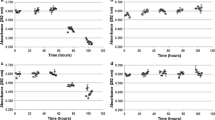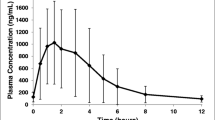Summary
The methods available for assaying ranitidine in plasma and both the drug and its metabolites in urine are high-performance liquid chromatography and radioimmunoassay. Following oral administration, the absorption of ranitidine in normal individuals has been found to be rapid, with peak plasma concentrations occurring at 1 to 3 hours. Peak plasma concentrations bear a constant relationship to dose, but vary widely between individuals. The bioavailability of ranitidine after oral administration is approximately 50% due to presystemic hepatic metabolism. Plasma protein binding of ranitidine is approximately 15% and the apparent volume of distribution is greater than body volume. Ranitidine penetrates very poorly into the cerebrospinal fluid but is concentrated into breast milk.
After intravenous administration, plasma concentrations decay in a biexponential manner. The elimination half-life is almost 2 hours and is somewhat longer after oral administration. Plasma clearance is approximately 600 ml/min of which most is renal clearance. Elimination of ranitidine is not dose-dependent. Hepatic metabolism is the other major route of elimination and there may be some enterohepatic recycling of the drug.
Food has no effect on the kinetics of ranitidine but concurrent administration of antacids reduces its absorption. Renal disease causes an increase in ranitidine plasma concentrations through reduced clearance and possibly increased bioavailability. Chronic liver disease causes an increase in the bioavailability of ranitidine and some reduction in clearance. In the elderly, there is a reduction in clearance and prolongation of the elimination half-life but little effect on bioavailability. There is a relationship between plasma concentrations of ranitidine and suppression of gastric acid production but wide interindividual variability.
Similar content being viewed by others
References
Berstad, A.; Frislid, K. and Rydning, A.: Relationship between ranitidine plasma levels and reduction of post prandial intragastric acidities in healthy man. Scandinavian Journal of Gastroenterology 17: 109–112 (1982).
Bogucs, K.; Dixon, G.T.; Fowler, P.; Jenner, W.N.; MacOnochie, J.O.; Martin, L.E. and Willoughby, B.A.: Pharmacokinetics and bioavailability of ranitidine in humans. British Journal of Pharmacology 73: 275–276 (1981).
Brogden, R.N.; Carmine, A.A.; Heel, R.C.; Speight, T.M. and Avery, G.S.: Ranitidine: A review of its pharmacology and therapeutic use in peptic ulcer disease and other allied diseases. Drugs 24: 267–303 (1982).
Carey, P.F. and Martin, L.E.: High performance liquid chromatography method for the determination of ranitidine in plasma. Journal of Liquid Chromatography 2: 1291–1303 (1979).
Carey, P.F.; Martin, L.E. and Owen, P.E.: Determination of ranitidine and its metabolites in human urine by reversed phase ion pair high performance liquid chromatography. Journal of Cinematography 225: 161–168 (1981).
Chau, N.P.; Zeeh, P.Y.; Pozct, N. and Hadj-Aissa, A.: Ranitidine kinetics in normal subjects. Clinical Pharmacology and Therapeutics 31: 770–774 (1982).
Eshelman, F.N.: Garg, D.C. and Weidler, D.J.: Clinical pharmacokinetics of ranitidine following multiple dose administration intravenously. Drug Intelligence and Clinical Pharmacy 15: 478 (1981).
Eshelman, F.N.; Plachetka, J.R. and Brown, D.C.P.: Bioavailability and tolerance of repealed intramuscular injections of ranilidine. Clinical Pharmacology and Therapeutics 33: 251 (1983a).
Eshelman, F.N.; Plachetka, J.R. and Brown, D.C.P.: Effect of antacid and anticholincrgic medication on ranitidine absorption. Clinical Pharmacology and Therapeutics 33: 216 (1983b).
Frislid, K. and Berstad, A.: High dose of antacid reduces bio-availability of ranitidine. British Medical Journal 286: 1358 (1983).
Garg, D.C.; Weidler, D.J. and Eshelman, F.N.: Ranitidine bio-availability and kinetics in normal male subjects. Clinical Pharmacology and Therapeutics 33: 445–451 (1981).
Hirschowitz, B.I.; Danilewitz, M. and Molina, E.: Inhibition of basal acid, chloride and pepsin secretion in duodenal ulcer by graded doses of ranitidine and atropine with studies of pharmacokinctics of ranitidine. Gastroenterology 82: 1314–1326 (1982).
Jenner, W.N.; Martin, L.E.; Willoughby, B. and Fellows, I.: The development of a radio-immunoassay for ranitidine in biological fluids. Life Sciences 28: 1323–1329 (1981).
Lebert, P.A.; MacLeod, S.M.; Mahon, W.A.; Soldin, S.J. and Vandenberghe, H.M.: Ranitidine kinetics and dynamics. I. Oral dose studies. Clinical Pharmacology and Therapeutics 30: 539–544 (1981a).
Lebert, P.A.; Mahon, W.A.; MacLeod, S.M.; Soldin, S.J.; Fenje, P. and Vandenberghe, H.M.: Ranitidine kinetics and dynamics. II. Intravenous dose studies and comparison with Cimetidine. Clinical Pharmacology and Therapeutics 30: 545–550 (1981b).
Martin, L.E.; Bell, J.A.; Carey, P.F.; Dallas, F.A.A.; Dixon, G.T. and Jenner, W.N.: A review of the pharmacokinetics and metabolism of ranitidine in animals and man; in Misiewicz and Wormsley (Eds) The Clinical Use of Ranitidine. Medicine Publishing Foundation Series 5. pp. 23–31 (Medicine Publishing Foundation, Oxford 1982a).
Martin, L.E.; Oxford, J. and Tanner, R.J.N.: Use of high performance liquid chromatography mass spectrometry for the study of the metabolism of ranitidine in man. Journal of Chromatography 251: 215–224 (1982b).
McFadyen, M.L.; Folb, P.I.; Marks, I.N.; Wright, J.P. and Lucke, W.: The pharmacokinetics of ranitidine in patients with chronic duodenal ulceration. Scandinavian Journal of Gastroenterology 16: 109–113 (1981a).
McFadyen, M.L.; Folb, P.I.; Miller, R.; Keeton, G.R. and Marks, I.N.: Pharmacokinetics of ranitidine in patients with chronic renal failure. European Journal of Clinical Pharmacology 25: 347–351 (1983).
McFadyen, M.L.; Folb, P.I.; Miller, R.; Marks, I.N. and Moshal, M.G.: The pharmacokinctics of ranitidine in patients with chronic duodenal ulceration: A comparison of responders and non responders. European Journal of Clinical Pharmacology 24: 441–447 (1983).
McGonigle, R.J.S.; Williams, L.C.; Amphlett, G.E.; England, R.J. and Parsons, V.: The pharmacokinetics of ranitidine in renal disease; in Misiewicz and Wormsley (Eds) The Clinical use of Ranitidine. Medicine Publishing Foundation Scries 5. pp 41–46 (Medicine Publishing Foundation, Oxford 1982).
McNeil, J.J.; Mihaly, G.W.; Anderson, A.; Marshall, A.W.; Smallwood, R.A. and Louis, W.J.: Pharmacokineties of the H2 receptor antagonist ranitidine in man. British Journal of Clinical Pharmacology 12: 411–415 (1981).
Mignon, M.; Chau, N.P.; Nguyen-Phuoc, B.K.; Sauvage, M.; Le-guy, F. and Bonfils, S.: Ranitidine upon meal induced gastric secretion, oral pharmacokinetics and plasma concentration effect relationships. British Journal of Clinical Pharmacology 14: 187–193 (1982).
Mihaly, G.W.; Drummer, O.H.; Marshall, A.; Smallwood, R.A. and Louis, W.J.: High pressure liquid Chromatographie determination or ranitidine — a new H2 receptor antagonist in plasma and urine. Journal of Pharmacological Sciences 69: 1155–1157 (1980).
Mihaly, G.W.; Marino, A.T.; Webster, L.K.; Jones, D.B.; Louis, W.J. and Smallwood, R.A.: High dose of antacid (Mylanta 11) reduces bioavailability of ranitidine. British Medical Journal 285: 998–999 (1982).
Peden, N.R.; Richards, D.A.; Saunders, J.H.B. and Wormsley, K.G.: Pharmacologically effective plasma concentrations of ranitidine. Lancet 2: 199–200 (1979).
Riley, A.J.; Crowley, P. and Harrison, C.: Transfer of ranitidine to biological fluids: Milk and semen; in Misiewicz and Wormsley (Eds) The Clinical Use of Ranitidine. Medicine Publishing Foundation Series 5. pp. 77–86 (Medicine Publishing Foundation, Oxford 1982).
Roberts, A.P.; Dixon, G.T.; Harrison, C. and Curtis, J.R.: Plasma ranitidine concentrations after intravenous administration in normal volunteers and haemodialysis patients. Postgraduate Medical Journal 59: 25–27 (1983).
Sewing, K.-Fr: Pharmacodynamics and pharmacokinetics of ranilidine in man; in Misiewicz and Wormsley (Eds) The Clinical Use of Ranilidine. Medicine Publishing Foundation Series 5. pp. 32–40 (Medicine Publishing Foundation, Oxford 1982).
Van Hecken, A.M.: Tjandramaga, T.B.; Mullie, A.; Verbesselt, R. and DeSchepper, P.J.: Ranitidine: Single dose pharmacokinetics and absolute bioavailability in man. British Journal of Clinical Pharmacology 14: 195–200 (1982).
Wall, R.P.; LaBrooy, S.J.; Avgerinos, A.; Oehr, T.; Riley, A. and Misiewicz, J.J.: Investigations on the penetration of ranitidine into the cerebrospinal fluid and a comparison of the effects of ranitidine and Cimetidine on male sex hormones. Scandinavian Journal of Gastroenlerology 16: 19–25 (1981).
Woodings, E.P.; Dixon, G.T.; Harrison, C.; Carey, P. and Richards, D.A.: Ranitidine — a new H2 receptor antagonist. Gut 21: 187–191 (1980).
Young, C.J.; Daneshmend, T.K. and Roberts, C.J.C.: Effects of cirrhosis and ageing on the elimination and bioavailability of ranilidine. Gut 23: 819–823 (1982).
Author information
Authors and Affiliations
Rights and permissions
About this article
Cite this article
Roberts, C.J.C. Clinical Pharmacokinetics of Ranitidine. Clin Pharmacokinet 9, 211–221 (1984). https://doi.org/10.2165/00003088-198409030-00003
Published:
Issue Date:
DOI: https://doi.org/10.2165/00003088-198409030-00003




